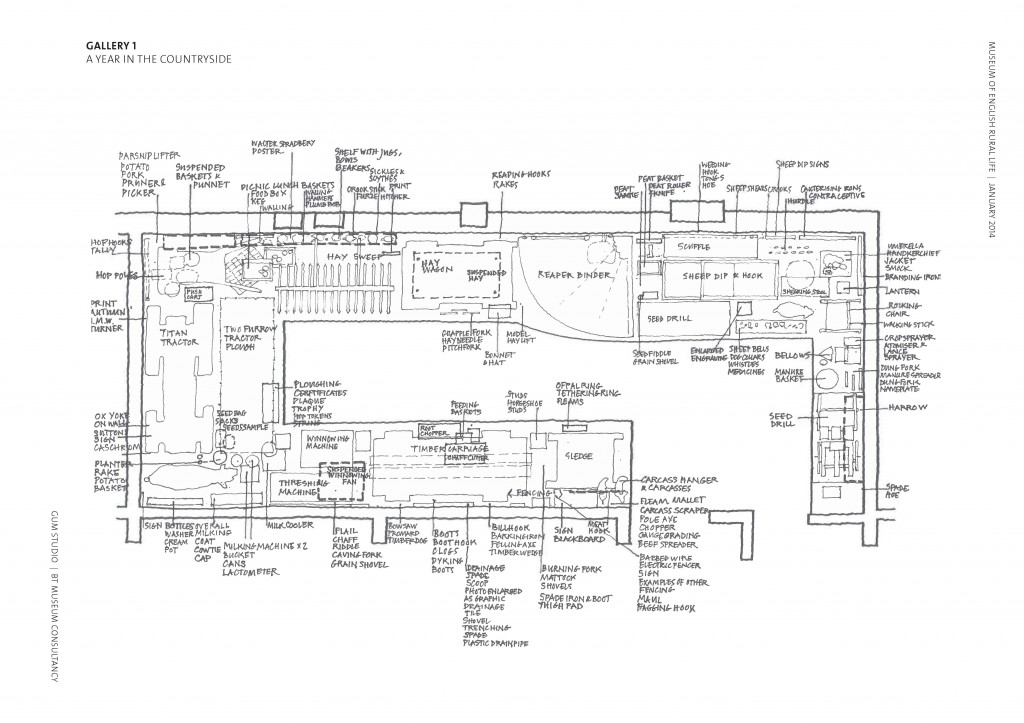written by Adam Koszary, Project Officer.
You may have noticed that we’ve been a bit quiet recently about our HLF-funded redevelopment project, Our Country Lives. This is because we’re waiting for a response from the Heritage Lottery Fund due on June 13th (fingers crossed), but also because a lot of us have been busy catching up on other projects such as Reading Connections, Countryside21 and A Sense of Place.  Last week, however, has seen the project kick-started again with a couple of meetings focusing on how we should be researching the stories and objects we want to put into the new displays, as well as how we should be marketing the new MERL. We’re also reaching a stage where I can give more detailed project updates, and this series of posts will probably focus more on the research-side of things, as well as some behind-the-scenes of how we go about delivering such a huge project as Our Country Lives. To recap our research so far, we spent a lot the 2013 winter and spring of 2014 getting to grips with the huge amount of objects and archives in the MERL collection. As well as trying to make sure we’re representing the countryside in all of its complexity and diversity, we have to make sure that we’re choosing the best objects and archives for the job, backed up by solid and current research.
Last week, however, has seen the project kick-started again with a couple of meetings focusing on how we should be researching the stories and objects we want to put into the new displays, as well as how we should be marketing the new MERL. We’re also reaching a stage where I can give more detailed project updates, and this series of posts will probably focus more on the research-side of things, as well as some behind-the-scenes of how we go about delivering such a huge project as Our Country Lives. To recap our research so far, we spent a lot the 2013 winter and spring of 2014 getting to grips with the huge amount of objects and archives in the MERL collection. As well as trying to make sure we’re representing the countryside in all of its complexity and diversity, we have to make sure that we’re choosing the best objects and archives for the job, backed up by solid and current research.
The stories we want to tell about rural life are sometimes driven by our objects, archival documents, video footage, or other types of media. Sometimes a problem can be that we do not have any objects to illustrate stories we want to tell, but in our case our problem is having too many objects. Did you know we have around 26,000 objects, archives covering 4,500 linear metres and a library of over 50,000 volumes? It’s obviously a good thing that we have such a large and diverse collection, but this is also a double-edged sword. Our museum has no off-site storage, and so everything has to fit into the galleries, mezzanine storage, and a new duplicate store which is being built at the back. Because of this, much of our work so far has been trying to find a place for all of our objects so that our designers could decide where to put essential things such as walls and doorways.
This is one of the reasons why we are putting our wagons in a line along the north wall; as well as being a new and interesting way of exploring this nationally important collection, it is also one of the only ways to fit them all into the galleries. The only other option was to have a few wagons in every single gallery, which we thought would overshadow the other collections. As for the rest of the collection, we have been combing through our catalogue and placing our objects into the galleries and storylines best suited for them. You can see an example of one of our spreadsheets below, which will be the base from which we decide where and why to put our objects, including how they fit in with key messages, generic learning outcomes and storylines. We will also work from these lists to engage in more detailed research on specific objects and subjects contained within the new galleries. The storylines and topics we want to explore are by no means final, however, and so we will also be spending a lot of time in the coming months ironing out our topics, consulting with experts, and having lengthy debates about what is in and what is out.
Essentially, the planning and delivery an almost entirely new museum is difficult and complicated, but it is also a rewarding and refreshing experience. If you would like to know a bit more about this aspect of the project or the project as a whole, feel free to drop me an email at a.j.koszary@reading.ac.uk , and keep an eye out for future updates.



